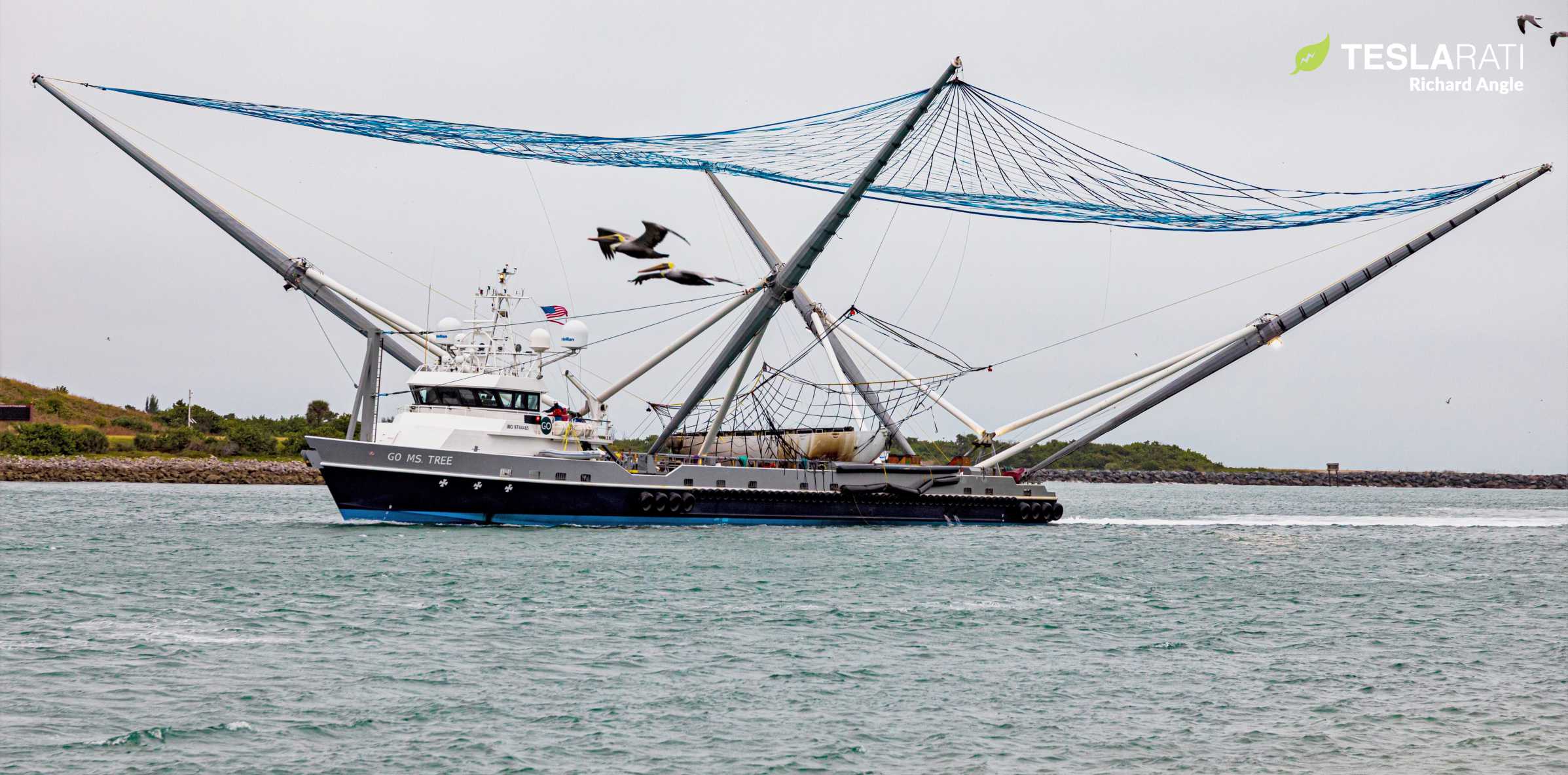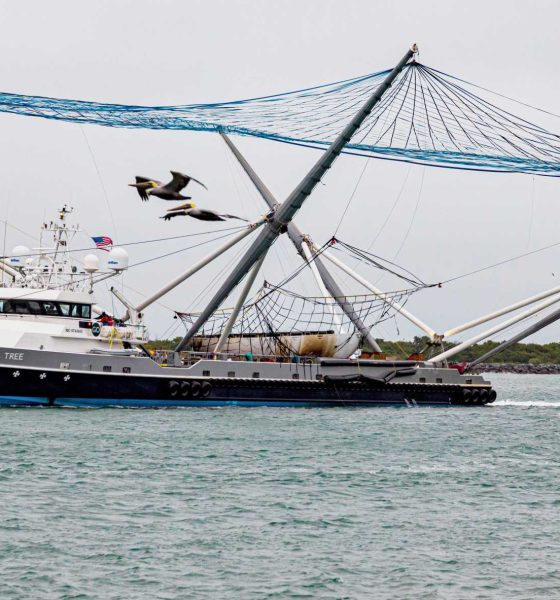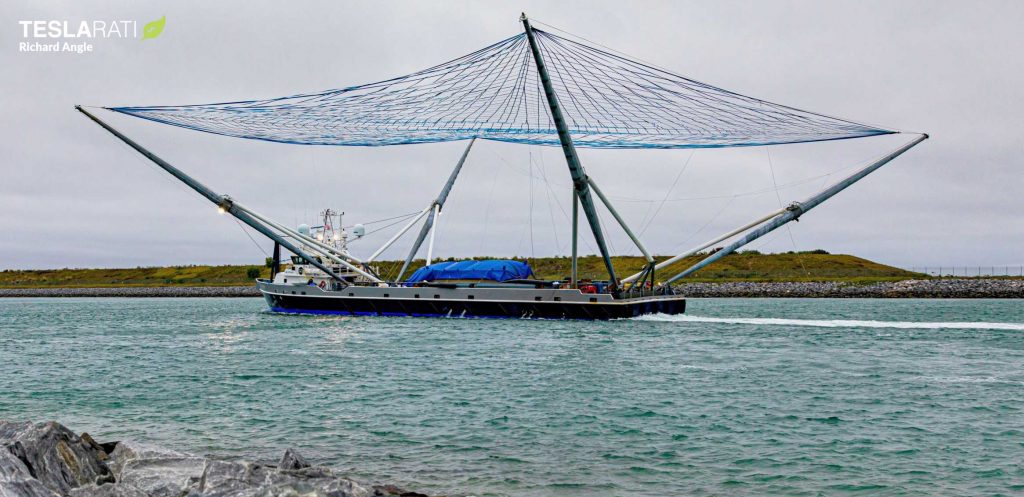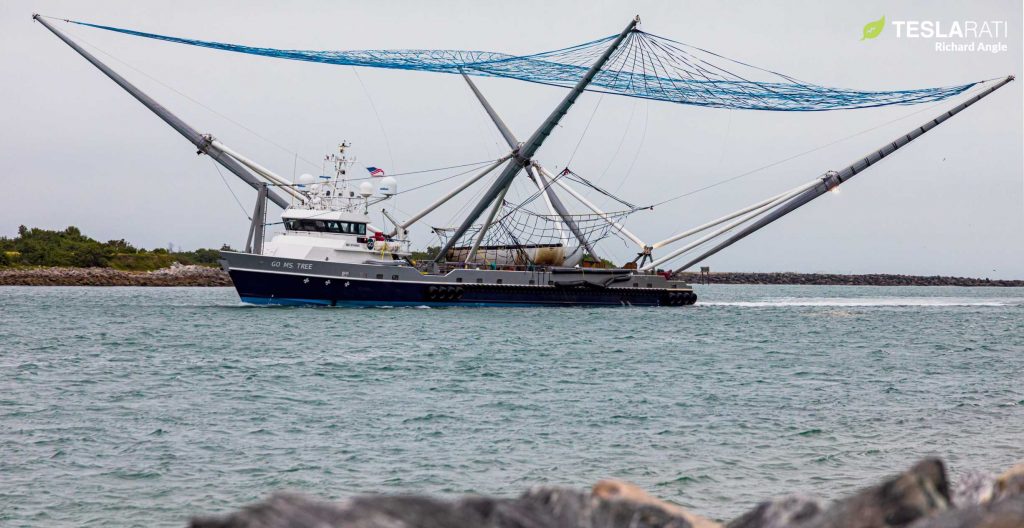

News
SpaceX fairing recovery ships return to port with Falcon 9 nosecone and battle scars
Four days after they headed out into the Atlantic Ocean, twin SpaceX fairing recovery ships Ms. Tree and Ms. Chief have returned to port with both halves of a Falcon 9 fairing, although they appear to have picked up some battle scars along the way.
Ms. Tree and its near-identical sibling Ms. Chief departed Port Canaveral on December 14th and arrived on station – 790 km (490 mi) off the coast of Florida – some 36 hours later. Each outfitted with a quartet of arms and pair of nets, it was the first time both ships successfully made it out into the Atlantic for a simultaneous fairing catch attempt, having been foiled by high seas during a prior November outing.
For unknown reasons, after the duo’s November false start, both ships stopped for almost two weeks at a South Carolina port, perhaps indicating that SpaceX was concerned about the structural integrity of the ships’ seemingly fragile net mechanism. In February 2019, Mr. Steven (now Ms. Tree) lost two of its four arms while heading downrange for an attempted catch, apparently broken off by pitching caused by high seas. Further strengthening the case that their net mechanisms are rather fragile, both Ms. Tree and Ms. Chief again suffered damage after their Kacific-1/JCSAT-18 Falcon 9 fairing recovery attempt.
Both ships arrived back at Port Canaveral on December 18th and were caught by Teslarati photographer Richard Angle while passing through the narrow mouth of the port. GO Ms. Chief took the lead, revealing a Falcon 9 fairing half snugly secured with a tarp on her deck – the ship’s very first launch vehicle hardware recovery.

First (partially) successful fairing recovery quite literally under wraps, Ms. Chief nevertheless did not make it through the rite of passage unscathed. Oddly, it appears that just one of the ship’s eight white arm supports is missing (the rear right or aft starboard arm), visibly resulting in the arm slouching a bit compared to its siblings. Intriguingly, it appears that the arm is partially stretching – and thus potentially resting on – Ms. Chief’s net and rigging.
The fact that only one of the arm’s two beams (of eight total) seems to have failed is more immediately indicative of possible human error during installation or a defective attachment mechanism, although it’s entirely possible that a fluke of weather could have damaged just the one beam.


Thankfully, Ms. Tree (formerly Mr. Steven) appears to have made it through the recovery mission with all four arms fully intact, although the ship clearly struggled with a separate mechanism. Notably, Ms. Tree seems to have struggled to use its secondary net to lift its fairing half out of the sea and onto her deck, with that smaller net clearly suffering a multitude of rips and tears at some point during the process. Her recovered fairing half is somewhat awkwardly strewn on the deck with no obvious attempt to rectify the issue, indicating that the net may have torn mid-lift, causing the fairing to fall maybe 5-10 feet.
If it did actually fall onto Ms. Tree’s deck, that will almost certainly be visible in the form of damage to its aluminum-composite honeycomb structure and white insulation coating.

Ultimately, fairing recovery continues to prove itself to be a major challenge, although SpaceX obviously has no intention of giving up. With two successful catches already in hand, it’s clear that fairing recovery is undeniably possible and is more a matter of tweaking existing systems than starting from scratch. Much like Falcon 9 booster recovery had and its fair share of failed landings even after the first success, it will likely take quite a while for SpaceX to optimize fairing recovery to the point that it can be considered reliable.
For now, routine fairing recovery and reuse will likely continue to be Falcon 9’s white whale, at worst adding to the excitement of every SpaceX satellite launch.
Check out Teslarati’s Marketplace! We offer Tesla accessories, including for the Tesla Cybertruck and Tesla Model 3.

News
Tesla is not sparing any expense in ensuring the Cybercab is safe
Images shared by the longtime watcher showed 16 Cybercab prototypes parked near Giga Texas’ dedicated crash test facility.

The Tesla Cybercab could very well be the safest taxi on the road when it is released and deployed for public use. This was, at least, hinted at by the intensive safety tests that Tesla seems to be putting the autonomous two-seater through at its Giga Texas crash test facility.
Intensive crash tests
As per recent images from longtime Giga Texas watcher and drone operator Joe Tegtmeyer, Tesla seems to be very busy crash testing Cybercab units. Images shared by the longtime watcher showed 16 Cybercab prototypes parked near Giga Texas’ dedicated crash test facility just before the holidays.
Tegtmeyer’s aerial photos showed the prototypes clustered outside the factory’s testing building. Some uncovered Cybercabs showed notable damage and one even had its airbags engaged. With Cybercab production expected to start in about 130 days, it appears that Tesla is very busy ensuring that its autonomous two-seater ends up becoming the safest taxi on public roads.
Prioritizing safety
With no human driver controls, the Cybercab demands exceptional active and passive safety systems to protect occupants in any scenario. Considering Tesla’s reputation, it is then understandable that the company seems to be sparing no expense in ensuring that the Cybercab is as safe as possible.
Tesla’s focus on safety was recently highlighted when the Cybertruck achieved a Top Safety Pick+ rating from the Insurance Institute for Highway Safety (IIHS). This was a notable victory for the Cybertruck as critics have long claimed that the vehicle will be one of, if not the, most unsafe truck on the road due to its appearance. The vehicle’s Top Safety Pick+ rating, if any, simply proved that Tesla never neglects to make its cars as safe as possible, and that definitely includes the Cybercab.
Elon Musk
Tesla’s Elon Musk gives timeframe for FSD’s release in UAE
Provided that Musk’s timeframe proves accurate, FSD would be able to start saturating the Middle East, starting with the UAE, next year.

Tesla CEO Elon Musk stated on Monday that Full Self-Driving (Supervised) could launch in the United Arab Emirates (UAE) as soon as January 2026.
Provided that Musk’s timeframe proves accurate, FSD would be able to start saturating the Middle East, starting with the UAE, next year.
Musk’s estimate
In a post on X, UAE-based political analyst Ahmed Sharif Al Amiri asked Musk when FSD would arrive in the country, quoting an earlier post where the CEO encouraged users to try out FSD for themselves. Musk responded directly to the analyst’s inquiry.
“Hopefully, next month,” Musk wrote. The exchange attracted a lot of attention, with numerous X users sharing their excitement at the idea of FSD being brought to a new country. FSD (Supervised), after all, would likely allow hands-off highway driving, urban navigation, and parking under driver oversight in traffic-heavy cities such as Dubai and Abu Dhabi.
Musk’s comments about FSD’s arrival in the UAE were posted following his visit to the Middle Eastern country. Over the weekend, images were shared online of Musk meeting with UAE Defense Minister, Deputy Prime Minister, and Dubai Crown Prince HH Sheikh Hamdan bin Mohammed. Musk also posted a supportive message about the country, posting “UAE rocks!” on X.
FSD recognition
FSD has been getting quite a lot of support from foreign media outlets. FSD (Supervised) earned high marks from Germany’s largest car magazine, Auto Bild, during a test in Berlin’s challenging urban environment. The demonstration highlighted the system’s ability to handle dense traffic, construction sites, pedestrian crossings, and narrow streets with smooth, confident decision-making.
Journalist Robin Hornig was particularly struck by FSD’s superior perception and tireless attention, stating: “Tesla FSD Supervised sees more than I do. It doesn’t get distracted and never gets tired. I like to think I’m a good driver, but I can’t match this system’s all-around vision. It’s at its best when both work together: my experience and the Tesla’s constant attention.” Only one intervention was needed when the system misread a route, showcasing its maturity while relying on vision-only sensors and over-the-air learning.
News
Tesla quietly flexes FSD’s reliability amid Waymo blackout in San Francisco
“Tesla Robotaxis were unaffected by the SF power outage,” Musk wrote in his post.

Tesla highlighted its Full Self-Driving (Supervised) system’s robustness this week by sharing dashcam footage of a vehicle in FSD navigating pitch-black San Francisco streets during the city’s widespread power outage.
While Waymo’s robotaxis stalled and caused traffic jams, Tesla’s vision-only approach kept operating seamlessly without remote intervention. Elon Musk amplified the clip, highlighting the contrast between the two systems.
Tesla FSD handles total darkness
The @Tesla_AI account posted a video from a Model Y operating on FSD during San Francisco’s blackout. As could be seen in the video, streetlights, traffic signals, and surrounding illumination were completely out, but the vehicle drove confidently and cautiously, just like a proficient human driver.
Musk reposted the clip, adding context to reports of Waymo vehicles struggling in the same conditions. “Tesla Robotaxis were unaffected by the SF power outage,” Musk wrote in his post.
Musk and the Tesla AI team’s posts highlight the idea that FSD operates a lot like any experienced human driver. Since the system does not rely on a variety of sensors and a complicated symphony of factors, vehicles could technically navigate challenging circumstances as they emerge. This definitely seemed to be the case in San Francisco.
Waymo’s blackout struggles
Waymo faced scrutiny after multiple self-driving Jaguar I-PACE taxis stopped functioning during the blackout, blocking lanes, causing traffic jams, and requiring manual retrieval. Videos shared during the power outage showed fleets of Waymo vehicles just stopping in the middle of the road, seemingly confused about what to do when the lights go out.
In a comment, Waymo stated that its vehicles treat nonfunctional signals as four-way stops, but “the sheer scale of the outage led to instances where vehicles remained stationary longer than usual to confirm the state of the affected intersections. This contributed to traffic friction during the height of the congestion.”
A company spokesperson also shared some thoughts about the incidents. “Yesterday’s power outage was a widespread event that caused gridlock across San Francisco, with non-functioning traffic signals and transit disruptions. While the failure of the utility infrastructure was significant, we are committed to ensuring our technology adjusts to traffic flow during such events,” the Waymo spokesperson stated, adding that it is “focused on rapidly integrating the lessons learned from this event, and are committed to earning and maintaining the trust of the communities we serve every day.”








